2009 Hyundai Santa Fe wheel size
[x] Cancel search: wheel sizePage 149 of 269
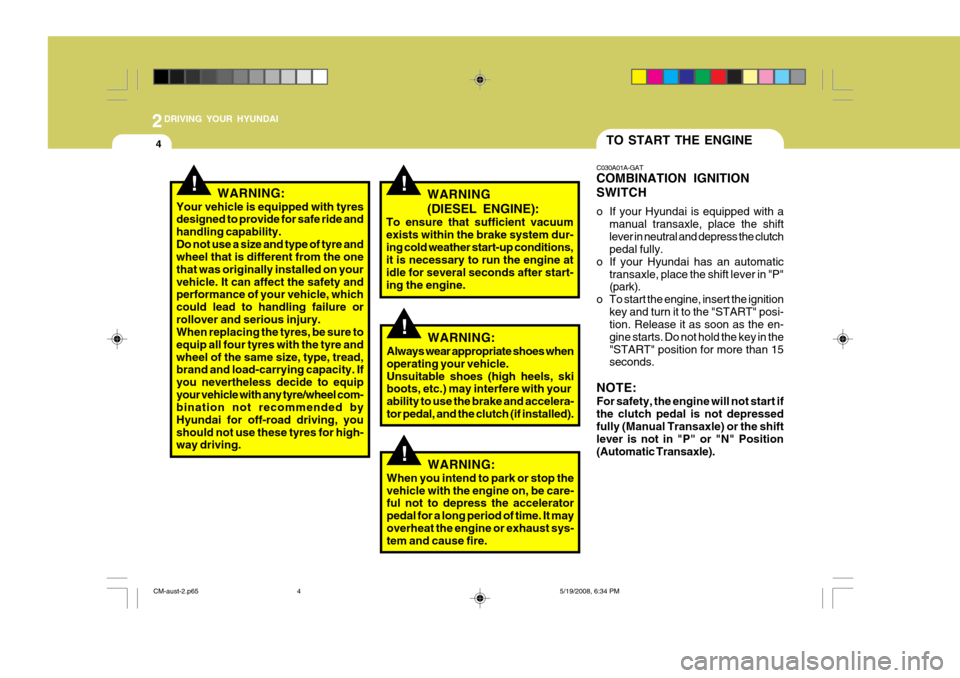
2DRIVING YOUR HYUNDAI
4
!
TO START THE ENGINE
C030A01A-GAT COMBINATION IGNITION SWITCH
o If your Hyundai is equipped with a manual transaxle, place the shift lever in neutral and depress the clutch pedal fully.
o If your Hyundai has an automatic
transaxle, place the shift lever in "P"(park).
o To start the engine, insert the ignition key and turn it to the "START" posi-tion. Release it as soon as the en- gine starts. Do not hold the key in the"START" position for more than 15 seconds.
NOTE: For safety, the engine will not start if the clutch pedal is not depressed
fully (Manual Transaxle) or the shift lever is not in "P" or "N" Position(Automatic Transaxle).
WARNING:
Your vehicle is equipped with tyres designed to provide for safe ride and handling capability.Do not use a size and type of tyre and wheel that is different from the one that was originally installed on yourvehicle. It can affect the safety and performance of your vehicle, which could lead to handling failure orrollover and serious injury. When replacing the tyres, be sure to equip all four tyres with the tyre andwheel of the same size, type, tread, brand and load-carrying capacity. If you nevertheless decide to equipyour vehicle with any tyre/wheel com- bination not recommended by Hyundai for off-road driving, youshould not use these tyres for high- way driving.
!WARNING:
Always wear appropriate shoes when operating your vehicle.Unsuitable shoes (high heels, ski boots, etc.) may interfere with your ability to use the brake and accelera-tor pedal, and the clutch (if installed).
!WARNING (DIESEL ENGINE):
To ensure that sufficient vacuum exists within the brake system dur-ing cold weather start-up conditions, it is necessary to run the engine at idle for several seconds after start-ing the engine.
!WARNING:
When you intend to park or stop the vehicle with the engine on, be care- ful not to depress the accelerator pedal for a long period of time. It mayoverheat the engine or exhaust sys- tem and cause fire.
CM-aust-2.p65 5/19/2008, 6:34 PM
4
Page 160 of 269
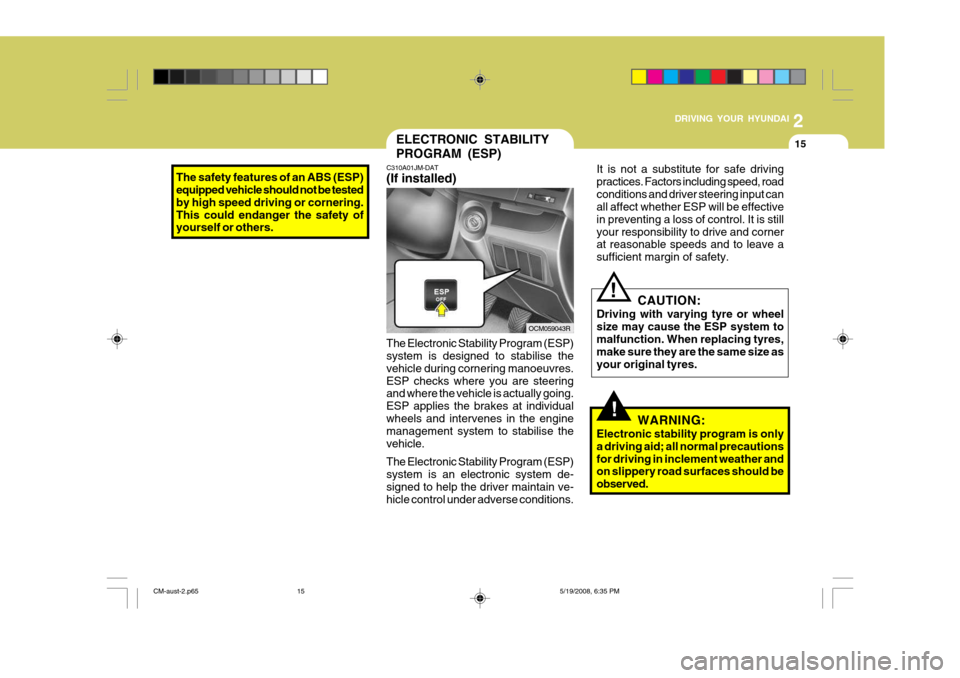
2
DRIVING YOUR HYUNDAI
15
The safety features of an ABS (ESP) equipped vehicle should not be tested by high speed driving or cornering.This could endanger the safety of yourself or others.
!
It is not a substitute for safe driving practices. Factors including speed, roadconditions and driver steering input can all affect whether ESP will be effective in preventing a loss of control. It is stillyour responsibility to drive and corner at reasonable speeds and to leave a sufficient margin of safety.
CAUTION:
Driving with varying tyre or wheelsize may cause the ESP system to malfunction. When replacing tyres, make sure they are the same size asyour original tyres.
WARNING:
Electronic stability program is onlya driving aid; all normal precautionsfor driving in inclement weather and on slippery road surfaces should be observed.
!
ELECTRONIC STABILITY PROGRAM (ESP)
C310A01JM-DAT (If installed) The Electronic Stability Program (ESP) system is designed to stabilise the vehicle during cornering manoeuvres.ESP checks where you are steering and where the vehicle is actually going. ESP applies the brakes at individualwheels and intervenes in the engine management system to stabilise the vehicle. The Electronic Stability Program (ESP) system is an electronic system de-signed to help the driver maintain ve- hicle control under adverse conditions. OCM059043R
CM-aust-2.p65
5/19/2008, 6:35 PM
15
Page 162 of 269
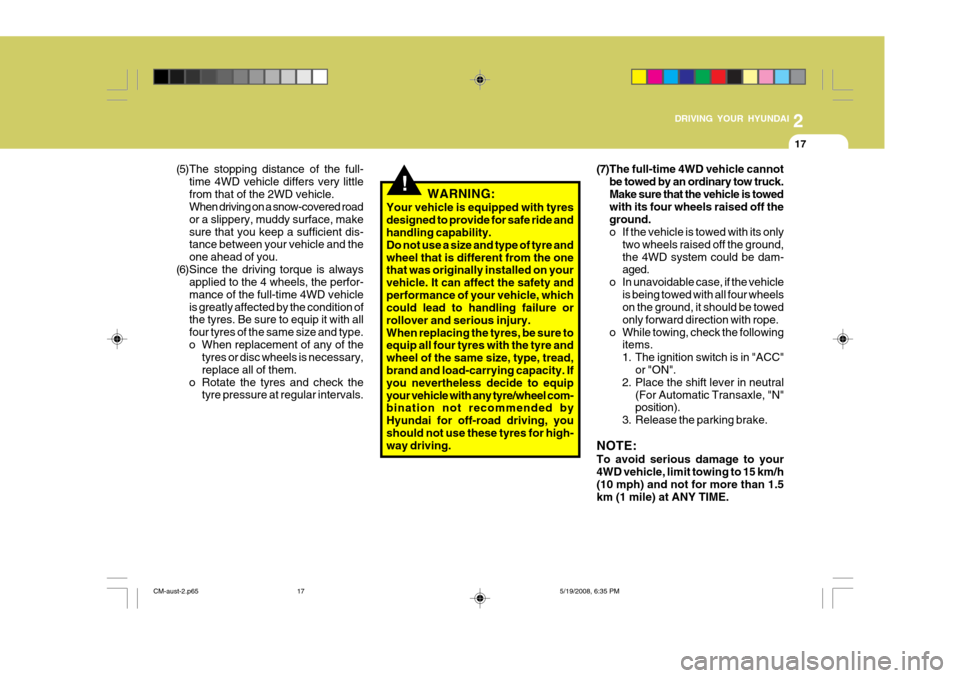
2
DRIVING YOUR HYUNDAI
17
!
(7)The full-time 4WD vehicle cannot
be towed by an ordinary tow truck. Make sure that the vehicle is towed with its four wheels raised off the ground.
o If the vehicle is towed with its only two wheels raised off the ground,the 4WD system could be dam- aged.
o In unavoidable case, if the vehicle
is being towed with all four wheelson the ground, it should be towed only forward direction with rope.
o While towing, check the following items.
1. The ignition switch is in "ACC" or "ON".
2. Place the shift lever in neutral
(For Automatic Transaxle, "N" position).
3. Release the parking brake.
NOTE: To avoid serious damage to your 4WD vehicle, limit towing to 15 km/h (10 mph) and not for more than 1.5km (1 mile) at ANY TIME.
(5)The stopping distance of the full-
time 4WD vehicle differs very littlefrom that of the 2WD vehicle. When driving on a snow-covered road or a slippery, muddy surface, makesure that you keep a sufficient dis- tance between your vehicle and the one ahead of you.
(6)Since the driving torque is always applied to the 4 wheels, the perfor-mance of the full-time 4WD vehicleis greatly affected by the condition of the tyres. Be sure to equip it with all four tyres of the same size and type.
o When replacement of any of the tyres or disc wheels is necessary,replace all of them.
o Rotate the tyres and check the tyre pressure at regular intervals. WARNING:
Your vehicle is equipped with tyresdesigned to provide for safe ride and handling capability. Do not use a size and type of tyre andwheel that is different from the one that was originally installed on your vehicle. It can affect the safety andperformance of your vehicle, which could lead to handling failure or rollover and serious injury.When replacing the tyres, be sure to equip all four tyres with the tyre and wheel of the same size, type, tread,brand and load-carrying capacity. If you nevertheless decide to equip your vehicle with any tyre/wheel com-bination not recommended by Hyundai for off-road driving, you should not use these tyres for high-way driving.
CM-aust-2.p65 5/19/2008, 6:35 PM
17
Page 181 of 269
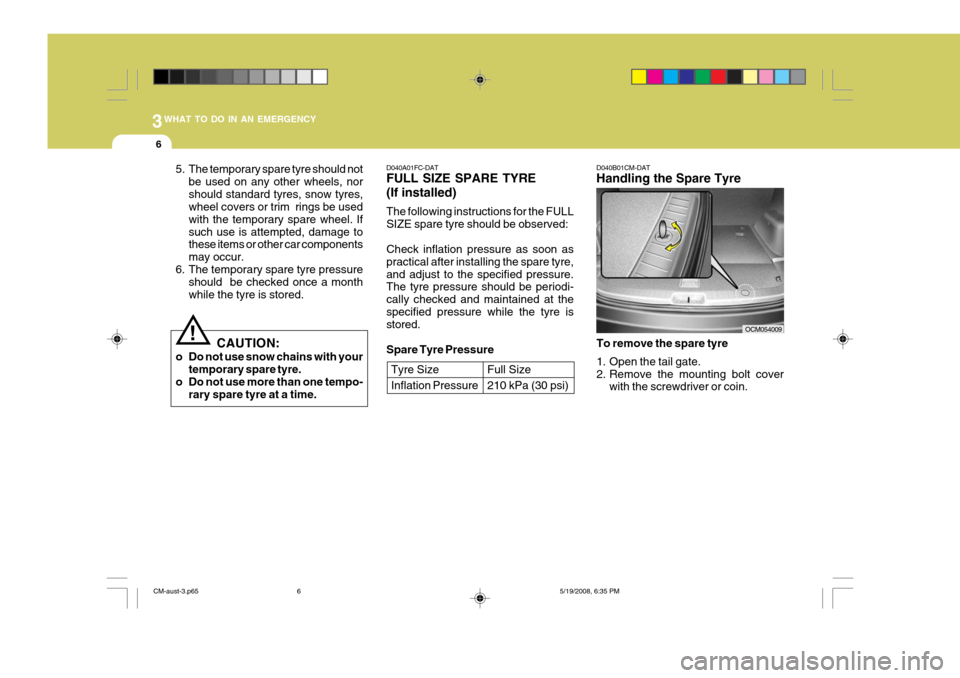
3WHAT TO DO IN AN EMERGENCY
6
D040A01FC-DAT FULL SIZE SPARE TYRE (If installed) The following instructions for the FULL SIZE spare tyre should be observed: Check inflation pressure as soon as practical after installing the spare tyre,and adjust to the specified pressure. The tyre pressure should be periodi- cally checked and maintained at thespecified pressure while the tyre is stored. Spare Tyre Pressure
Full Size 210 kPa (30 psi)
Tyre Size Inflation Pressure D040B01CM-DAT Handling the Spare Tyre
To remove the spare tyre
1. Open the tail gate.
2. Remove the mounting bolt cover with the screwdriver or coin.
OCM054009
5. The temporary spare tyre should not
be used on any other wheels, nor should standard tyres, snow tyres, wheel covers or trim rings be used with the temporary spare wheel. Ifsuch use is attempted, damage to these items or other car components may occur.
6. The temporary spare tyre pressure should be checked once a monthwhile the tyre is stored.! CAUTION:
o Do not use snow chains with your temporary spare tyre.
o Do not use more than one tempo-
rary spare tyre at a time.
CM-aust-3.p65 5/19/2008, 6:35 PM
6
Page 183 of 269

3WHAT TO DO IN AN EMERGENCY
8
!
1VQA4023
o The wheel diagonally opposite from the one to be changed should be blocked. 1. Remove the spare tyre and remove
the jack and tool from luggage com-partment.
NOTE: The spare tyre is located underneath the car.
WARNING:
Your vehicle is equipped with tyresdesigned to provide for safe ride andhandling capability. Do not use a size and type of tyre and wheel that is different from the onethat was originally installed on your vehicle. It can affect the safety and performance of your vehicle, whichcould lead to handling failure or rollover and serious injury. When replacing the tyres, be sure toequip all four tyres with the tyre and wheel of the same size, type, tread, brand and load-carrying capacity. Ifyou nevertheless decide to equip your vehicle with any tyre/wheel com- bination not recommended byHyundai for off-road driving, you should not use these tyres for high- way driving. o Allow the vehicle speed to decrease,
without using the brakes if possible.
o Pull off the road or into the curb where it is safe to do so and stop thevehicle. Turn off the engine.
o Activate the hazard warning lamp, apply the parking brake and placethe transaxle in gear ("P" position forAutomatic Transaxle).
o Passengers should not remain in-
side the vehicle during wheel chang-ing.
OCM054008
Flat tyre
CM-aust-3.p65 5/19/2008, 6:35 PM
8
Page 256 of 269
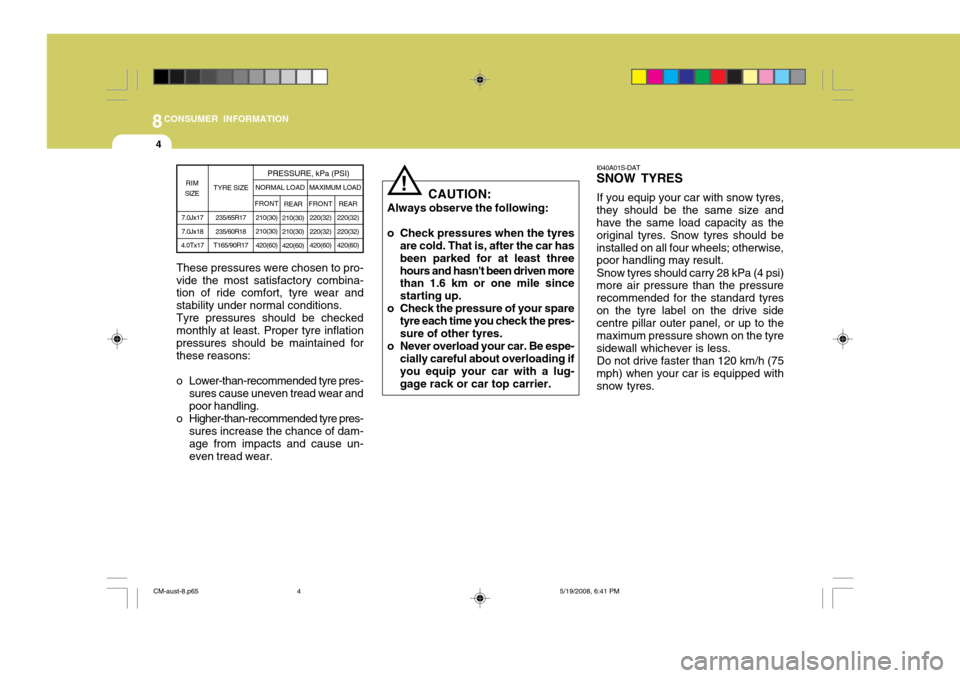
8CONSUMER INFORMATION
4
!
CAUTION:
Always observe the following:
o Check pressures when the tyres are cold. That is, after the car has been parked for at least threehours and hasn't been driven more than 1.6 km or one mile since starting up.
o Check the pressure of your spare tyre each time you check the pres-sure of other tyres.
o Never overload your car. Be espe- cially careful about overloading if you equip your car with a lug- gage rack or car top carrier. I040A01S-DAT
SNOW TYRES
If you equip your car with snow tyres,
they should be the same size and have the same load capacity as the original tyres. Snow tyres should beinstalled on all four wheels; otherwise, poor handling may result.
Snow tyres should carry 28 kPa (4 psi)
more air pressure than the pressure recommended for the standard tyreson the tyre label on the drive side centre pillar outer panel, or up to the maximum pressure shown on the tyresidewall whichever is less.
Do not drive faster than 120 km/h (75
mph) when your car is equipped withsnow tyres.
These pressures were chosen to pro-vide the most satisfactory combina- tion of ride comfort, tyre wear and stability under normal conditions.Tyre pressures should be checkedmonthly at least. Proper tyre inflationpressures should be maintained for these reasons:
o Lower-than-recommended tyre pres-
sures cause uneven tread wear and poor handling.
o Higher-than-recommended tyre pres-
sures increase the chance of dam- age from impacts and cause un- even tread wear.
7.0Jx17 7.0Jx18
4.0Tx17 TYRE SIZE
RIM
SIZE PRESSURE, kPa (PSI)
235/65R17235/60R18
T165/90R17 REAR
210(30)210(30)420(60) FRONT
220(32)220(32) 420(60)
NORMAL LOAD
MAXIMUM LOAD
REAR
220(32) 220(32) 420(60)
FRONT
210(30) 210(30)420(60)
CM-aust-8.p65 5/19/2008, 6:41 PM
4
Page 257 of 269
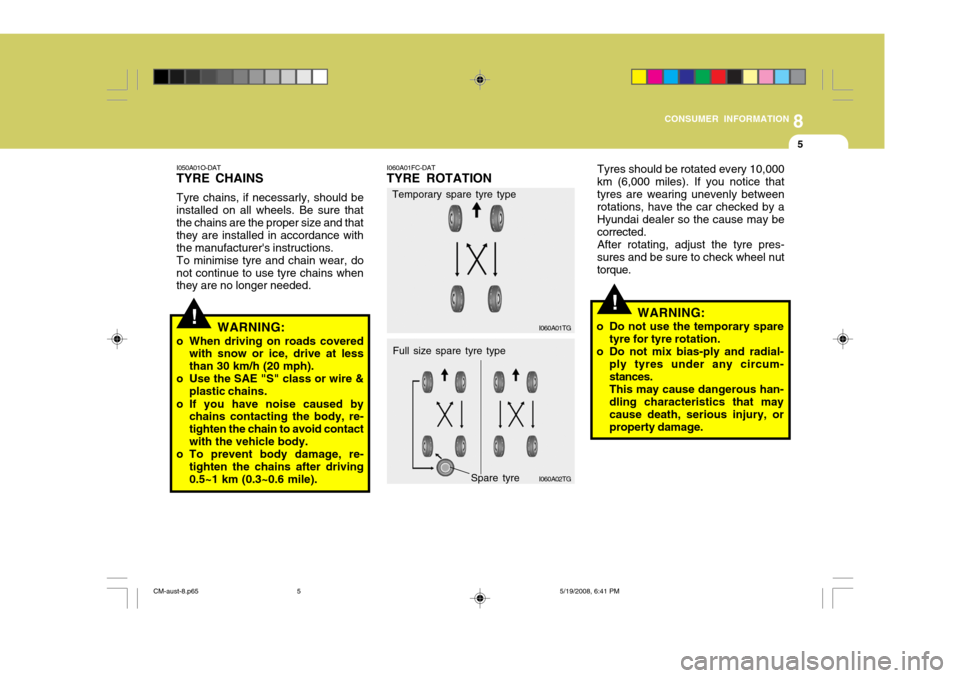
8
CONSUMER INFORMATION
5
!
!
Tyres should be rotated every 10,000
km (6,000 miles). If you notice that tyres are wearing unevenly between rotations, have the car checked by a Hyundai dealer so the cause may becorrected. After rotating, adjust the tyre pres-
sures and be sure to check wheel nuttorque.
I060A01FC-DAT
TYRE ROTATION
WARNING:
o Do not use the temporary spare tyre for tyre rotation.
o Do not mix bias-ply and radial- ply tyres under any circum-stances. This may cause dangerous han- dling characteristics that may cause death, serious injury, orproperty damage.
I050A01O-DAT
TYRE CHAINS
Tyre chains, if necessarly, should be
installed on all wheels. Be sure that the chains are the proper size and that they are installed in accordance withthe manufacturer's instructions. To minimise tyre and chain wear, do
not continue to use tyre chains when they are no longer needed.
WARNING:
o When driving on roads covered with snow or ice, drive at less than 30 km/h (20 mph).
o Use the SAE "S" class or wire &
plastic chains.
o If you have noise caused by chains contacting the body, re-tighten the chain to avoid contactwith the vehicle body.
o To prevent body damage, re- tighten the chains after driving 0.5~1 km (0.3~0.6 mile).
I060A01TG
I060A02TGSpare tyre
Temporary spare tyre type
Full size spare tyre type
CM-aust-8.p65 5/19/2008, 6:41 PM
5
Page 258 of 269
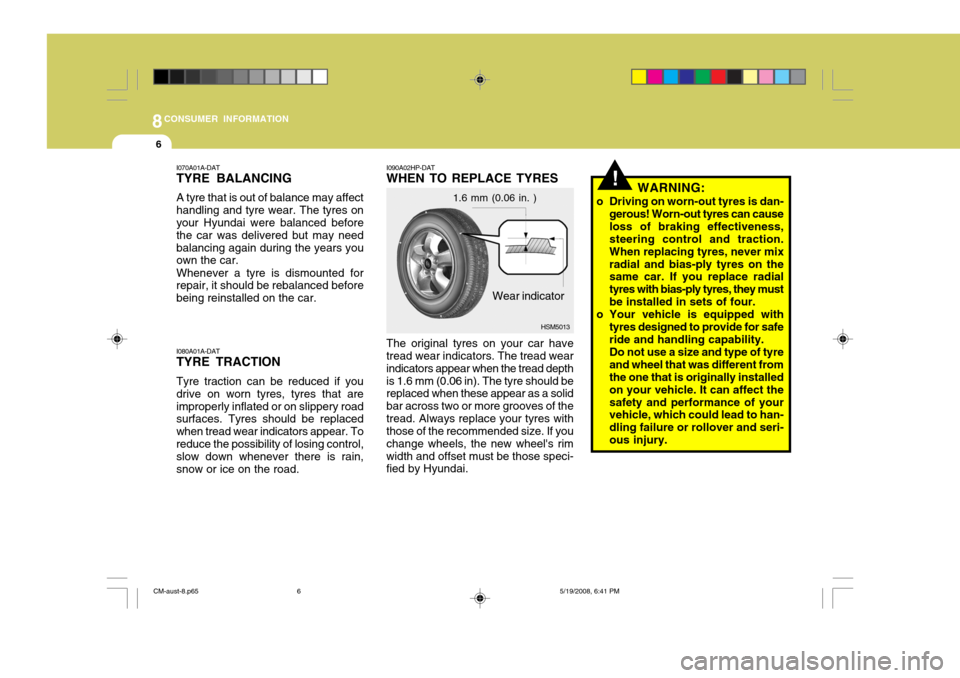
8CONSUMER INFORMATION
6
!
I090A02HP-DAT WHEN TO REPLACE TYRES The original tyres on your car have tread wear indicators. The tread wear indicators appear when the tread depthis 1.6 mm (0.06 in). The tyre should be replaced when these appear as a solid bar across two or more grooves of thetread. Always replace your tyres with those of the recommended size. If you change wheels, the new wheel's rimwidth and offset must be those speci- fied by Hyundai.
Wear indicator
1.6 mm (0.06 in. )
HSM5013 WARNING:
o Driving on worn-out tyres is dan- gerous! Worn-out tyres can cause loss of braking effectiveness, steering control and traction. When replacing tyres, never mixradial and bias-ply tyres on the same car. If you replace radial tyres with bias-ply tyres, they mustbe installed in sets of four.
o Your vehicle is equipped with tyres designed to provide for safe ride and handling capability. Do not use a size and type of tyre and wheel that was different from the one that is originally installed on your vehicle. It can affect thesafety and performance of your vehicle, which could lead to han- dling failure or rollover and seri-ous injury.
I070A01A-DAT TYRE BALANCING A tyre that is out of balance may affect handling and tyre wear. The tyres on your Hyundai were balanced before the car was delivered but may needbalancing again during the years you own the car. Whenever a tyre is dismounted for repair, it should be rebalanced before being reinstalled on the car. I080A01A-DAT TYRE TRACTION Tyre traction can be reduced if you drive on worn tyres, tyres that areimproperly inflated or on slippery road surfaces. Tyres should be replaced when tread wear indicators appear. Toreduce the possibility of losing control, slow down whenever there is rain, snow or ice on the road.
CM-aust-8.p65
5/19/2008, 6:41 PM
6